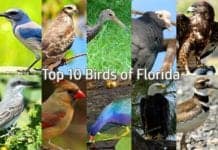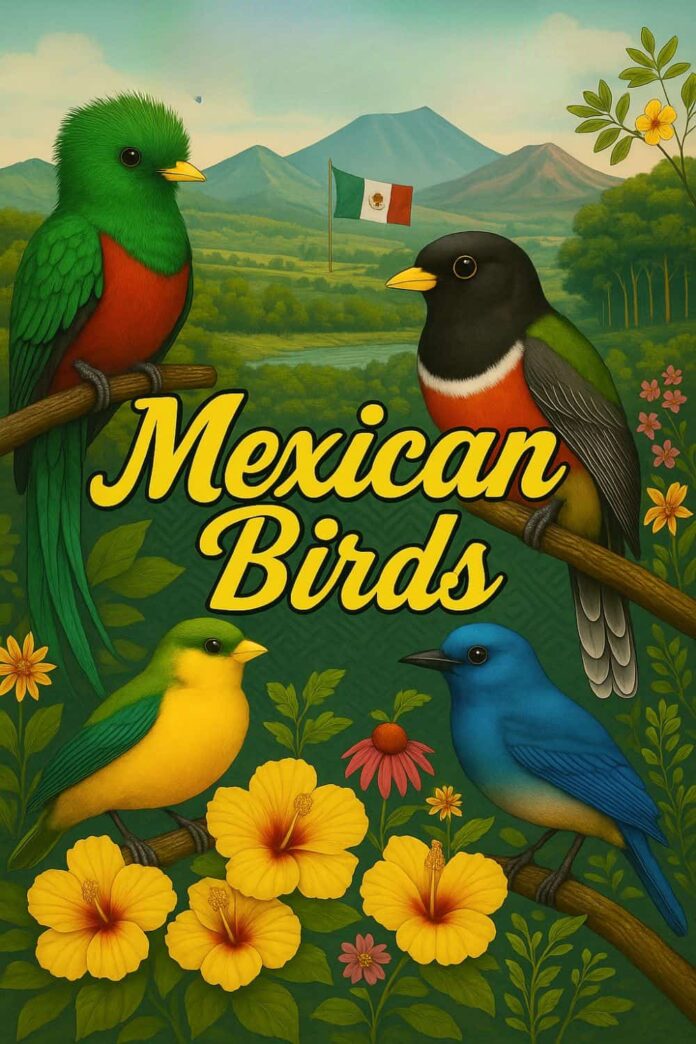
Mexican Birds: Mexico is known for much more than tacos and beaches. It’s also one of the richest bird countries on Earth. Mexico has over 1,100 bird species, which makes it a dream country for any bird lover. Mexico is home to birds of every feather in all colors and sizes. From hummingbirds that are smaller than your thumb to big ones with rainbow-colored feathers, the skies and forests of this nation are buzzing with life all year.
Across Mexico, you can find all types of land; sandy deserts, moist rainforests, and huge mountains make up the country. This increasing variety can mean one thing; there is a safe spot for all types of birds. Some bird species are endemic to Mexico and only live there. Others use Mexico as a pit stop when migrating to and from North and South America.
The BioExplorer discusses the Top 15 Mexican birds that you must know. If you’re planning a trip to go bird-watching or love to learn about nature, you’ll meet some real stunners.
Get ready to embark on a journey through Mexico and learn all about their colorful native birds and their natural habitats, along with their wild and wonderful behaviors!
Table of Contents
- Why Is Mexico a Birdwatcher’s Dream?
- How Many Bird Species Are Native to Mexico?
- Top Mexican Birds
- 1. Resplendent Quetzal
- 2. Elegant Trogon
- 3. Mexican Jay
- 4. Orange-breasted Bunting
- 5. Crimson-collared Grosbeak
- 6. Black-throated Magpie-Jay
- 7. Pink-headed Warbler
- 8. Socorro Dove
- 9. Bumblebee Hummingbird
- 10. Blue Mockingbird
- 11. Red Warbler
- 12. Slaty Vireo
- 13. Ocellated Turkey
- 14. Russet-crowned Motmot
- 15. Violet-crowned Hummingbird
- Wrap-up
Why Is Mexico a Birdwatcher’s Dream?

Regarding birds, Mexico sits at the top of the list. Mexico is home to remarkable environments where birds thrive in their natural habitat. Birdwatchers from all over the world come here for good reason.
Here’s why Mexico stands out:
- Mexico has all sorts of different landscapes. It features cloud forests, mangroves, rainforests, deserts, mountains, and nearly 9,000 kilometers of coastline. There are plenty of bird species found nowhere else.
- Mexico is located along the Pacific and Atlantic flyways, a substantial migratory pathway. Millions of birds pass through every spring and fall, a once-in-a-lifetime experience.
- In Mexico, you will find over 100 species of birds that cannot be found elsewhere. For example, you can spot the Pink-headed Warbler and Slaty Vireo, which cannot be seen anywhere else.
- Birds are not just animals in Mexico but powerful cultural connections. Different types of eagles, along with many other birds, feature heavily in ancient myths, sacred stories, and national identity. The Golden Eagle even sits at the center of Mexico’s flag.
- Thanks to the region’s mild winters, birds’ flocks return to Montana year after year. Any day of the year, something is active somewhere in the endless variety of regions and elevations of Mexico, from dry to rainy.
Mexico doesn’t just have birds. Birding in the region is rich, rewarding, and always surprising.
How Many Bird Species Are Native to Mexico?

Mexico isn’t just bird-rich — it’s one of the most bird-rich countries on Earth. With over 1,100 recorded species, it ranks among the top 11 nations globally for bird diversity. That’s more birds than you’ll find in the United States or Canada.
Here’s a quick breakdown:
- Total species recorded: Around 1,100.
- Endemic species: Over 100 birds are found only in Mexico.
- Migratory visitors: Roughly 200 species pass through or winter in Mexico every year.
- Globally threatened species: Close to 100 species in Mexico are considered at risk.
Why so many birds in one country?
- Extreme habitat diversity: From alpine peaks and volcanic slopes to coastal mangroves and desert plains, Mexico packs nearly every type of bird habitat into one nation.
- Geographic placement: Sitting between North and South America, Mexico is a natural bridge for bird migration and evolution.
- Elevation shifts: Quick elevation changes create micro-habitats. You’ll find species suited to radically different climates a few miles apart.
How does Mexico compare?
- United States: About 1000+ bird species.
- Australia: Roughly 830+ species.
- Mexico: Tops both with ease around 1100+ avian species.
Some hotspots in Mexico offer over 300 species in a single region. In places like Chiapas or Veracruz, a week of birding can fill your notebook faster than you think!
Top Mexican Birds
1. Resplendent Quetzal
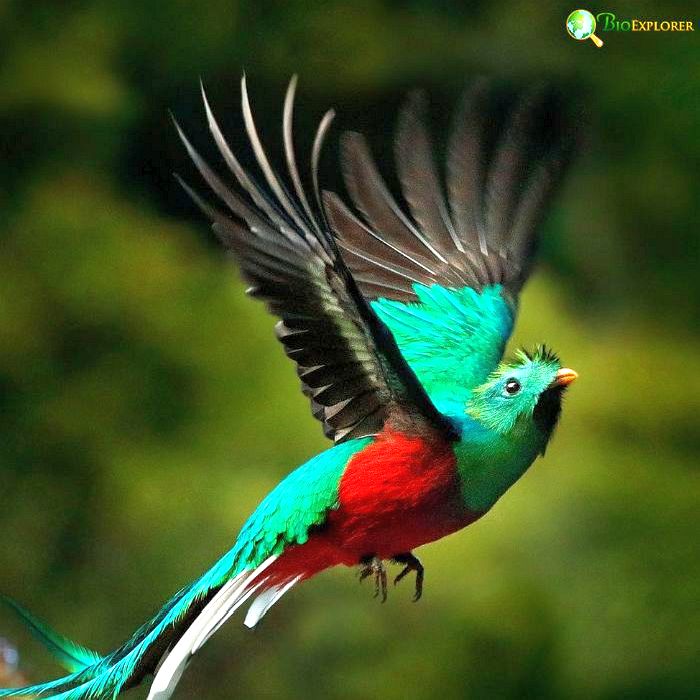
| Animalia | Trogoniformes | Trogonidae | Pharomachrus | Pharomachrus mocinno |
The Resplendent Quetzal is widely regarded as one of the world’s most beautiful birds, with males displaying iridescent emerald-green plumage and striking scarlet breasts. Their most distinctive feature is the pair of elongated upper tail coverts, which can extend up to 3 feet, trailing behind them as they move through the misty cloud forests.
This species is found in southern Mexico (notably in the highlands of Chiapas and protected areas like El Triunfo Biosphere Reserve), Central America, and western Panama. Resplendent Quetzals inhabit montane cloud forests, which are cool, moist, and rich in fruiting types of trees—especially species in the laurel family (Lauraceae), which are essential to their diet.
In Maya and Aztec cultures, the Resplendent Quetzal was revered as sacred. Its feathers were symbols of power and freedom, and harming the bird was taboo; feathers were collected and the birds released, reflecting the deep cultural respect that persists today.
Interesting Resplendent Quetzal Facts
- Cloud Forest Specialist: The Resplendent Quetzal is highly dependent on intact cloud forests, typically found at elevations between 4,000 and 10,500 feet. This habitat is among the most threatened in the world, making the quetzal a flagship species for cloud forest conservation.
- Fruit Specialist: While their diet includes a variety of fruits, they are especially reliant on wild avocados and other Laurel fruits. The timing and location of their movements are closely linked to the fruiting patterns of these trees.
- Key Seed Disperser: Quetzals play a crucial ecological role as seed dispersers, helping maintain the health and regeneration of cloud forests.
- Altitudinal Migrant: After the breeding season, quetzals often move to lower elevations in search of food, returning to higher cloud forests to breed.
- Conservation Status: The Resplendent Quetzal is listed as Near Threatened by the IUCN, with an estimated population of 20,000–49,999 individuals. Habitat loss due to deforestation, agriculture, and fragmentation is the primary threat.
- Ecotourism Value: In regions like Chiapas and Costa Rica, where both quetzals and Costa Rica monkeys draw nature enthusiasts, ecotourism has become a significant driver, providing economic incentives for local communities to preserve cloud forest habitats.
2. Elegant Trogon
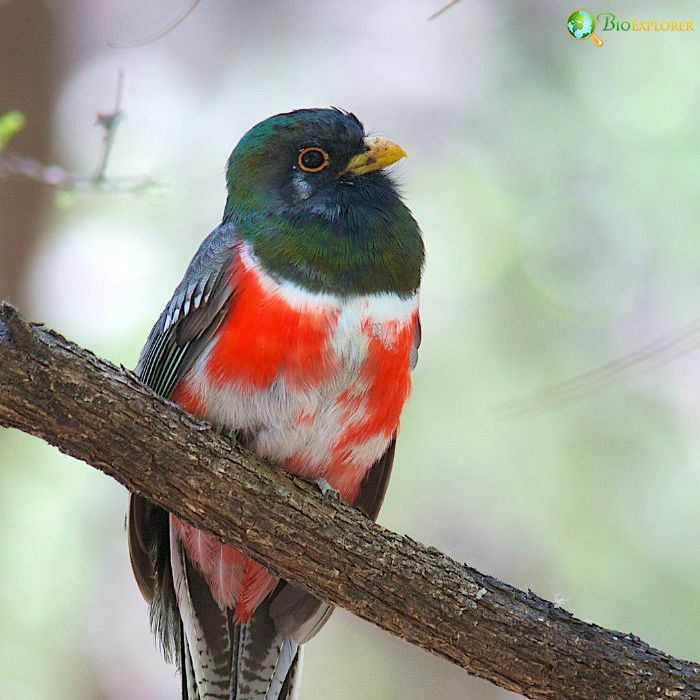
| Animalia | Trogoniformes | Trogonidae | Trogon | Trogon elegans |
The Elegant Trogon is instantly recognizable by its metallic green back, vivid red belly, and crisp white chest band. With a calm, deliberate presence, it moves quietly through the mid-canopy of woodlands, often remaining still and blending into the dappled light. Its distinctive, repetitive croaking or barking calls are often heard echoing through canyon forests before the bird is seen.
In Mexico, Elegant Trogons are most commonly found in the Sierra Madre Occidental, including Sonora, Chihuahua, Durango, and Sinaloa. They favor riparian corridors and canyons lined with sycamores, oaks, and cottonwoods, especially near streams and canyon bottoms. Key birding locations include Copper Canyon (Chihuahua), El Tuito (Jalisco), and the forests near Alamos (Sonora). While some northern populations migrate short distances, most Elegant Trogons in Mexico are year-round residents, thriving in undisturbed mid-elevation woodlands with abundant tall trees and fruit.
Interesting Elegant Trogon Facts
- Secondary Cavity Nester: Elegant Trogons cannot excavate their own nest holes. They rely on Woodpeckers, especially Northern Flickers and Acorn Woodpeckers, which not only carve cavities in trees but also play a key role in forest ecosystems based on what do woodpeckers eat, ranging from insects to acorns.
- Omnivorous Diet: Their diet includes different types of insects (especially grasshoppers, caterpillars, cicadas, and moths), small vertebrates such as lizards, and many fruits and berries. During the breeding season, animal prey makes up a larger proportion of their diet.
- Sit-and-Wait Predator: Trogons typically perch quietly at mid-canopy, scanning for prey. They hunt by making short flights to snatch insects or hover to pluck fruit from branches.
- Sexual Dimorphism: Males are brightly colored with iridescent green backs and red bellies, while females are duller, with brownish-gray tones and a white eye ring.
- Conservation Status: The Elegant Trogon is listed as Least Concern by the IUCN. However, populations are sensitive to the loss of riparian habitats and water table declines, threatening their dependence on the sycamore and cottonwood forests.
- Northernmost Trogon: The Elegant Trogon is the northernmost species of trogon in the world, with its range extending from Central America into the southwestern United States, including rare breeding populations in Arizona.
- Ecological Role: Elegant Trogons help maintain the health and regeneration of riparian and woodland ecosystems by consuming and dispersing seeds from many fruiting Plants.
3. Mexican Jay
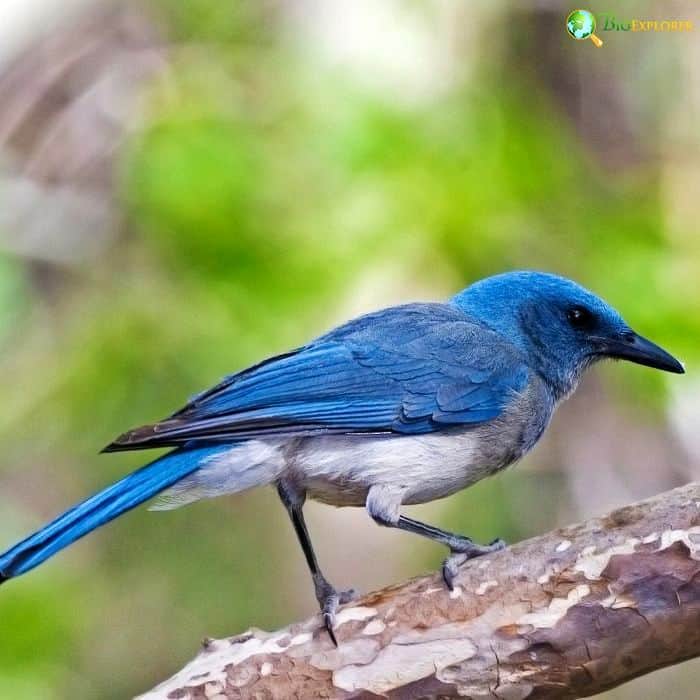
| Animalia | Passeriformes | Corvidae | Aphelocoma | Aphelocoma wollweberi |
The Mexican Jay is a striking bird of Mexico’s pine-oak and oak-conifer forests, instantly recognizable by its soft sky-blue upperparts and pale gray underparts. These jays are highly social, living in cohesive family groups that are rarely seen alone. Their lively calls and constant movement bring energy and sound to the cool, forested mountains of the Sierra Madre Occidental and other highland regions.
Mexican Jays are found in Mexico, primarily in the Sierra Madre Occidental, including states such as Sonora, Chihuahua, Durango, Zacatecas, and parts of Jalisco. They are especially abundant in areas like Copper Canyon (Barranca del Cobre) and the Sierra de los Ajos in northern Sonora, where large flocks roam the woodlands for food.
Mexican Jays are renowned for their intelligence and complex social structure. They practice cooperative breeding: several birds help at each nest, including offspring from previous years and sometimes unrelated adults. This teamwork extends to foraging, sentinel duties, and even food sharing, making them one of North America’s most behaviorally sophisticated birds.
Interesting Mexican Jay Facts
- Habitat Specialist: Mexican Jays primarily inhabit pine-oak and oak-juniper forests between 4,000 and over 11,000 feet in elevation, favoring areas rich in acorns and pine nuts.
- Seasonal Diet and Food Caching: Their diet shifts with the seasons—acorns and pine nuts are vital in winter (often cached for later use), while in summer, they consume insects, spiders, small reptiles, and even eggs or nestlings.
- Plural Breeding: Unlike most birds, multiple females in a group may breed simultaneously, and all group members—including non-breeding adults and young from previous broods—help feed and protect the chicks.
- Juvenile Development: Young Mexican Jays have pale bills that gradually darken with age, sometimes taking up to three years to become fully black.
- Learning and Intelligence: Mexican Jays are capable of social learning—individuals often observe and learn from others when solving problems or finding food, highlighting their cognitive complexity.
- Conservation Status: The species is currently listed as Least Concern by the IUCN and remains common across much of its range, though local populations can be threatened by habitat loss due to logging, agriculture, and fire.
4. Orange-breasted Bunting
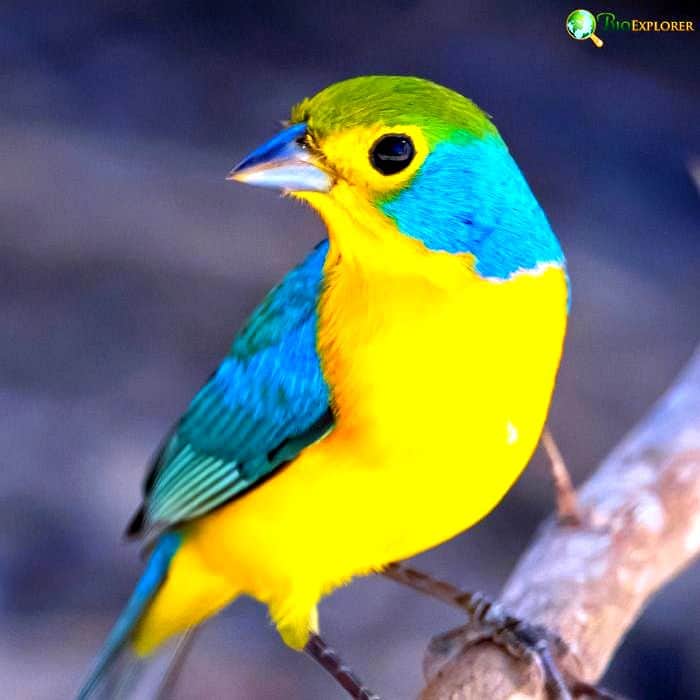
| Animalia | Passeriformes | Cardinalidae | Passerina | Passerina leclancherii |
The Orange-breasted Bunting looks like a painter’s wildest dream come true. Drenched in neon turquoise, lime green, and fiery orange, this tiny bird dazzles the eye even when perched quietly among the trees. Its vivid colors practically glow against the muted greens of its coastal habitat.
In Mexico, the Orange-breasted Bunting lives exclusively along the Pacific lowlands. Its range stretches from southern Nayarit through Jalisco, Colima, Michoacán, Guerrero, and western Oaxaca. Birdwatchers often find it near Puerto Vallarta (Jalisco) and along the coastal trails near Huatulco (Oaxaca), where tropical dry forests give way to scrubby clearings and brushy fields.
These buntings stick to lower elevations, usually below 3,000 feet, and prefer dry areas for much of the year. Males sing sweet, musical phrases from exposed perches during the breeding season, flashing their brilliant plumage to defend territory and attract mates.
Interesting Orange-breasted Bunting Facts
- Endemic to Mexico: The Orange-breasted Bunting is found nowhere else except in western and southwestern Mexico, from southern Nayarit through Jalisco, Colima, Michoacán, Guerrero, and western Oaxaca and Puebla.
- Two Subspecies: There are two recognized subspecies—P. l. leclancherii (coastal Guerrero) and P. l. grandior (from Nayarit to Chiapas and Puebla). Both are year-round residents, with slightly different ranges within the Pacific slope.
- Habitat Flexibility: This species thrives in secondary growth and disturbed habitats, often more abundant in these areas than in undisturbed forests. It is commonly found in pairs or small groups, foraging in dense, bushy vegetation near the ground.
- Sexual Dimorphism: Males are brilliantly colored with turquoise and orange, while females are much duller, sporting greenish upperparts and yellow underparts. This makes males easy to spot, but females can be quite inconspicuous.
- Conservation and Trade: Although the species is listed as Least Concern due to its wide range and stable population, it is a popular target in the caged bird trade, with thousands exported annually. Long-term threats include habitat loss from agriculture, cattle ranching, and timber removal.
5. Crimson-collared Grosbeak
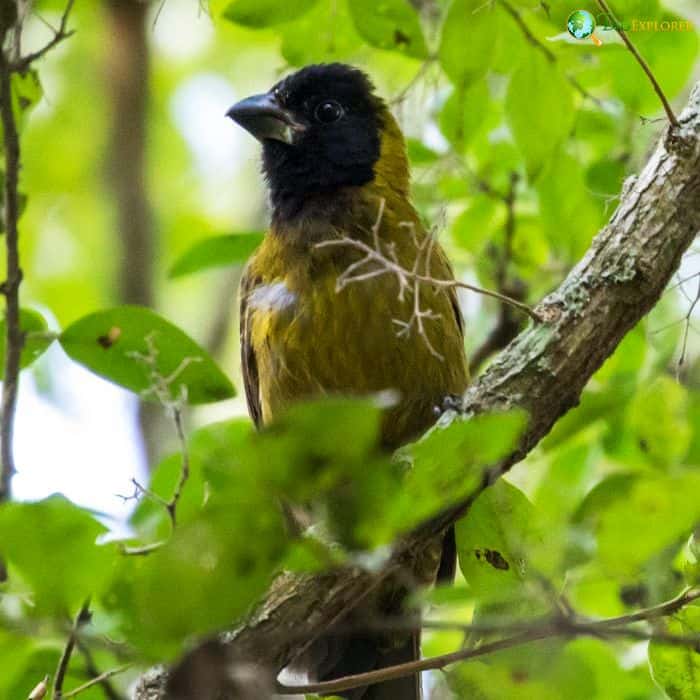
| Animalia | Passeriformes | Cardinalidae | Rhodothraupis | Rhodothraupis celaeno |
The Crimson-collared Grosbeak cuts a dramatic figure in the forest shadows, with males showing deep black plumage accented by a vivid blood-red hood and chest. Females, in contrast, wear greenish backs and yellowish underparts, with a bold black head and chest. With its stocky build and heavy seed-crushing beak, this bird brings a bold yet mysterious energy to Mexico’s humid forests.
In Mexico, Crimson-collared Grosbeaks are most common in the eastern lowlands. Their stronghold runs through the Gulf coastal plain from southern Tamaulipas into Veracruz and northern Oaxaca. Some of the best spots to glimpse them include the lush forests around El Cielo Biosphere Reserve (Tamaulipas) and the cloud forests near Xalapa (Veracruz).
These grosbeaks prefer shady understories in tropical and semi-evergreen forests, usually sticking close to dense thickets. They can be surprisingly secretive, slipping quietly through the leaves even though their bright colors make them easy to spot when entering open spaces.
Interesting Crimson-collared Grosbeak Facts
- Crimson-collared Grosbeaks prefer lowland and foothill forests, especially humid broadleaf areas between 1,000 and 5,000 feet.
- Their diet consists mainly of seeds, berries, soft fruits, and leaves, which they crack open easily using their powerful conical beaks.
- Males and females look quite different: males are black and red, while females are greenish-yellow with a black head and chest.
- While generally uncommon, these grosbeaks can be locally numerous in undisturbed forests. Still, they may vanish quickly when forests are fragmented or cleared for agriculture.
6. Black-throated Magpie-Jay

| Animalia | Passeriformes | Corvidae | Calocitta | Calocitta colliei |
The Black-throated Magpie-Jay looks like something straight out of a cartoon, with a spectacularly long tail, wild spiky crest, and brilliant blue, black, and white plumage. Loud, inquisitive, and highly social, this bird turns every sighting into a lively spectacle.
In Mexico, Black-throated magpie jays are found mainly along the Pacific coastal lowlands. Their range extends from southern Sonora through Sinaloa, Nayarit, Jalisco, and northwestern Colima. Popular birding spots like San Blas (Nayarit) and the dry forests near Mazatlán (Sinaloa) offer great chances to see them. They thrive in thorn forests, open woodlands, riparian areas, and even ranchlands, where they have room to forage and explore.
Groups of these magpie-jays are almost always noisy, flashing through trees with constant chattering and frequent aerial chases. They are bold around people, often raiding campsites or visiting backyards, making them a favorite among locals and birders.
Interesting Black-throated Magpie-Jay Facts
- Black-throated Magpie-Jays inhabit dry forests, thorn scrub, and semi-open landscapes, usually from sea level up to about 5,900 feet.
- Their omnivorous diet includes fruits, seeds, insects, small reptiles, eggs, and even chicks of other birds, showing remarkable adaptability.
- These jays travel in boisterous flocks that maintain complex social hierarchies, with helpers often assisting at the nest.
- The species is monogamous, with pairs mating for life and building large stick nests high in thorny trees for protection.
- They are among the world’s longest-tailed corvids, using their tails for balance as they move through the treetops.
7. Pink-headed Warbler

| Animalia | Passeriformes | Parulidae | Cardellina | Cardellina versicolor |
The Pink-headed Warbler resembles a puff of cotton candy darting through the misty woods. Its Rose-pink head and chest blend into silvery-gray wings and back, making it one of Mexico’s most charming and instantly recognizable small songbirds.
This warbler inhabits the highlands of southern Mexico, especially in Chiapas, and extends into western Guatemala. You’ll likely spot one in cloud forests and pine-oak woodlands around El Triunfo Biosphere Reserve (Chiapas) or the misty slopes near San Cristóbal de las Casas. They usually stay above 6,000 feet, favoring cool, mossy forests rich in epiphytes and dense undergrowth.
Pink-headed Warblers forage low in the vegetation, hopping methodically through thickets as they search for insects and spiders. Their soft, whistled songs blend beautifully into the gentle soundscape of highland forests, creating a peaceful, almost magical atmosphere for lucky visitors.
Interesting Pink-headed Warbler Facts
- Pink-headed Warblers are found in montane cloud forests and pine-oak woodlands, almost always at elevations above 6,000 feet, where mist and dense vegetation are common.
- Their diet is mainly insects and small arthropods, which they glean from leaves and twigs while foraging low to the ground.
- Unlike many warblers, the Pink-headed Warbler is a permanent resident of its highland home, rarely moving far, even with seasonal changes.
- The species is locally common in protected areas but faces ongoing threats from logging and agricultural expansion, fragmenting its fragile mountain habitat.
- Recent studies suggest their vivid pink coloration is possible because sedentary warblers like this species can invest more resources in pigment production than migratory relatives.
8. Socorro Dove
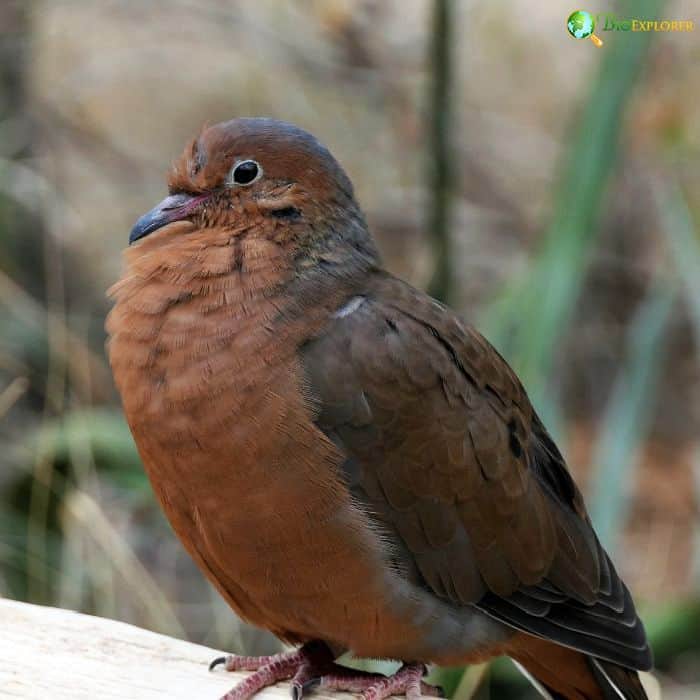
| Animalia | Columbiformes | Columbidae | Zenaida | Zenaida graysoni |
The Socorro Dove carries a quiet sadness. Once abundant on Socorro Island off Mexico’s Pacific coast, this cinnamon-brown dove vanished from the wild by the early 1970s. Today, it survives only in carefully managed captive breeding programs, where conservationists work to one day return it to its native island.
Socorro Island, part of the Revillagigedo Archipelago about 370 miles southwest of Baja California, was the dove’s only natural home. It thrived in dry forests and scrublands, feeding on seeds, berries, and fallen fruits among the native vegetation. The introduction of feral cats and overgrazing by sheep led to rapid decline, and the last wild Socorro Dove was seen in 1972.
Thanks to zoos and breeding centers in Mexico, the United States, and Europe, about 150–180 Socorro Doves exist today. Reintroduction efforts are underway, with aviaries built on the island and habitat restoration ongoing, including removing sheep and controlling feral cats. Seeing a Socorro Dove back in the wild would mark a major conservation milestone for Mexican birds.
Socorro Dove Facts
- Socorro Doves originally inhabited arid scrub and dry forests on Socorro Island, foraging and nesting mainly on the ground.
- Their diet consists mostly of seeds, berries, and fallen fruits, making them important for seed dispersal in their ecosystem.
- Males are deep cinnamon with a blue-grey nape and iridescent neck patch, while females and juveniles are duller in color.
- The advertising call is a rhythmic “Coo-oo, OO, OO, OO, Coo-oo”, echoing through the island’s open woodlands.
- Although extinct in the wild since 1972, dedicated breeding and reintroduction programs continue, hoping to restore a self-sustaining wild population on Socorro Island.
9. Bumblebee Hummingbird
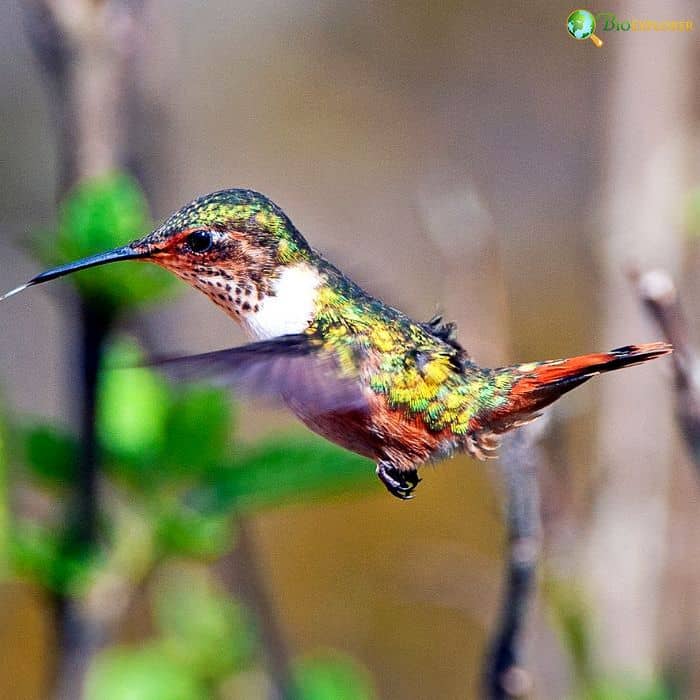
| Animalia | Apodiformes | Trochilidae | Atthis | Atthis heloisa |
The Bumblebee Hummingbird is one of the tiniest birds on Earth, weighing less than a penny and barely reaching three inches long. This energetic marvel flits through Mexico’s high mountain forests like a flying jewel, with males flashing a magenta throat and both sexes shimmering green above. Despite their size, they are bold and often zip past hikers with a loud, bee-like buzz.
Bumblebee Hummingbirds are found mainly in central and southern Mexico’s temperate and cloud forests, from Tamaulipas and Jalisco to Oaxaca and Guerrero. They thrive in pine-oak woodlands, humid forest edges, and shrubby clearings, usually at elevations between 4,900 and 9,800 feet. Birders may spot them around Nevado de Toluca or the slopes of Pico de Orizaba, darting between flowers and perching low in the brush.
Males perform dazzling courtship displays, hovering before females with their gorget flared and tail cocked, accompanied by a distinctive buzzing sound. Their nests, built from moss and lichens, are tucked on slender branches high above the ground.
Interesting Bumblebee Hummingbird Facts
- Bumblebee Hummingbirds inhabit pine-oak and cloud forests, sticking to elevations between 4,900 and 9,800 feet and often feeding at low and mid-level flowers.
- Their diet is mostly nectar from small flowers, but they also hunt tiny insects and spiders to fuel their high metabolism.
- Males’ magenta gorgets flash during courtship and territorial displays, and their wings produce a bee-like buzz that helps them slip past larger, aggressive hummingbirds.
- Nests are tiny cups made from moss and lichens, often placed up to 30 feet off the ground on thin branches.
- Although populations are stable and the species is listed as Least Concern, ongoing habitat loss in Mexican mountain forests remains a concern for their future.
10. Blue Mockingbird
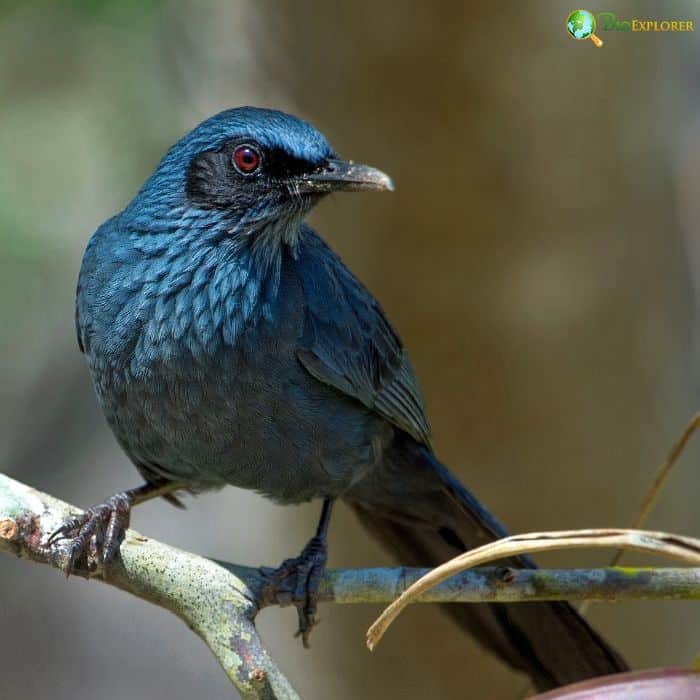
| Animalia | Passeriformes | Mimidae | Melanotis | Melanotis caerulescens |
The Blue Mockingbird, a member of the Mimids family, is a secretive, deep-blue songbird that prefers to stay hidden in thick vegetation. Its rich, structural blue feathers shimmer subtly in the dappled light, and its musical, varied songs drift through the dense undergrowth like whispers from the forest itself.
The Blue Mockingbird is found mainly in the interior uplands and western regions in Mexico, ranging through states like Jalisco, Michoacán, Guerrero, Oaxaca, Puebla, and Veracruz. It thrives particularly well around Bosque La Primavera (Jalisco) and the oak-pine slopes near Ciudad Hidalgo (Michoacán). This species favors moist, shady woodlands, tangled thickets, and brushy ravines, usually between 3,000 and 8,000 feet.
Unlike its noisier cousin, the Northern Mockingbird, the Blue Mockingbird tends to skulk out of sight. It prefers staying close to the ground, hopping through leaf litter or low bushes as it forages for insects, berries, and seeds.
Interesting Blue Mockingbird Facts
- Blue Mockingbirds live in dense oak, pine-oak, and tropical forests, sticking close to understory cover from lowlands up to 8,000 feet.
- Blue Mockingbirds’ diet includes insects, caterpillars, beetles, spiders, berries, and fruits like guava, foraged from the ground and low shrubs.
- Unlike many mockingbirds, Blue Mockingbird’s song is a musical, flute-like series of notes, not known for mimicry of other species.
- The blue color of their feathers is due to their microscopic feather structure, which is not pigmented, and Blue Mockingbirds can look gray in low light.
- While considered common within their range, habitat loss and fragmentation are causing slow declines, especially in central Mexico.
11. Red Warbler
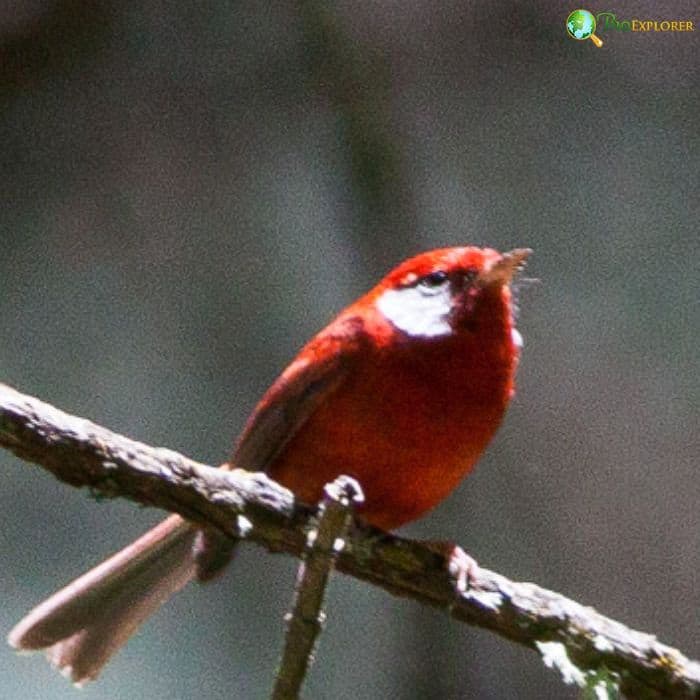
| Animalia | Passeriformes | Parulidae | Cardellina | Cardellina rubra |
The Red Warbler blazes like a spark in Mexico’s misty highland forests. Its fiery crimson body, paired with contrasting white or silvery ear patches depending on the region, makes it one of the most eye-catching birds darting through dense mountain vegetation.
Red Warblers are endemic to Mexico’s central and southern mountains in the Sierra Madre Occidental, Trans-Mexican Volcanic Belt, and Sierra Madre del Sur. You can spot them in states like Jalisco, Mexico State, Puebla, Veracruz, and Oaxaca, especially around La Malinche Volcano (Tlaxcala) and Nevado de Toluca (Mexico State), usually at elevations between 5,900 and 12,800 feet.
These warblers prefer cool, damp pine, fir, and pine-oak forests where thick moss covers the branches and mist cloaks the ground. They forage low to mid-level in the understory, energetically searching for insects and other small arthropods, often flicking their tails as they move.
Interesting Red Warbler Facts
- Red Warblers are found mainly in humid coniferous forests, living between 5,900 and 12,800 feet in elevation and migrating to lower oak forests in winter.
- Their diet consists almost entirely of insects and small arthropods gleaning from leaves, bark, and pine needles.
- Unlike many migratory warblers, Red Warblers are year-round residents, only moving altitudinally within their mountain ranges.
- Although still common in suitable habitats, Red Warblers face threats from habitat loss due to logging, agriculture, and climate change.
- Red Warblers are among the few known poisonous birds, with feathers that contain alkaloids making them unpalatable to predators and inedible to humans—a trait recognized by the Aztecs and confirmed by scientists.
12. Slaty Vireo

| Animalia | Passeriformes | Vireonidae | Vireo | Vireo brevipennis |
The Slaty Vireo is a hidden treasure of Mexico’s highlands. It is cloaked in deep slate-gray feathers, snowy white eyes, chin, and belly, and crisp green edges on its wings and tail. Unlike most vireos, which blend into the greenery, this one stands out with its elegant, polished look and long tail. It sticks to thick, tangled vegetation where it can forage and sing without drawing too much attention.
Slaty Vireos live across parts of Morelos, Puebla, Guerrero, and Oaxaca in Mexico. They thrive in dry oak scrub, thorn forests, and overgrown clearings, often favoring tangled underbrush at elevations between 4,000 and 8,000 feet. Areas like Lagunas de Zempoala National Park (Morelos) and brushy hillsides near Tehuacán (Puebla) are strongholds for these elusive songbirds.
Though difficult to spot, their sweet whistling songs often drift from dense cover, offering birdwatchers a clue to their hidden presence. Patience and a sharp ear are the best tools for finding this subtle but striking vireo.
Interesting Slaty Vireo Facts
- Unlike most vireos, the Slaty Vireo stands out with its unique slate-gray plumage, long tail, snowy white underparts, eyes, and chin.
- These birds spend much of their time low to the ground, moving slowly through dense thorny bushes, searching for insects and small fruits.
- Slaty Vireos are shy and rarely join mixed-species flocks, making them a challenge even for seasoned birders.
- They are non-migratory, remaining year-round in their rugged, highland habitats.
- Once placed in their own genus (Neochloe), Slaty Vireos are now recognized as one of the most distinctive vireos in the world.
13. Ocellated Turkey
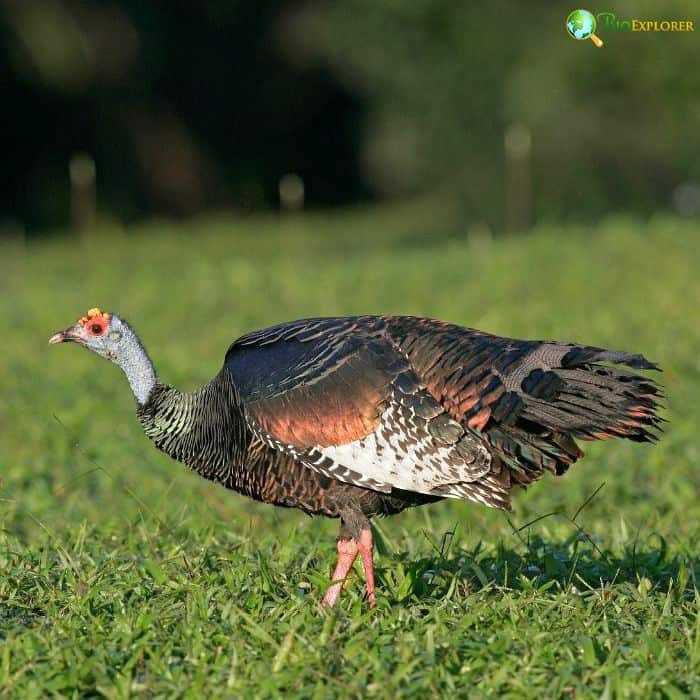
| Animalia | Galliformes | Phasianidae | Meleagris | Meleagris ocellata |
The Ocellated Turkey looks like it walked straight out of a mythical story. Its shimmering plumage gleams with metallic greens, blues, and bronzes, and its tail fans out to display bright, eye-shaped blue-green spots edged with gold. Lighter and more vividly colored than the Wild Turkey, the Ocellated Turkey is sleeker, smaller, and much more elusive in the wild.
In Mexico, this dazzling bird lives only on the Yucatán Peninsula, mainly across Campeche, Quintana Roo, and Yucatán, but also in Tabasco and Chiapas, as well as parts of Belize and Guatemala. It thrives in tropical forests and clearings in places like Calakmul Biosphere Reserve and Sian Ka’an Biosphere Reserve, preferring undisturbed jungle interiors but sometimes foraging in open fields or abandoned farmland. Unlike domesticated turkeys, Ocellated Turkey remains wild, moving cautiously through the shadows and rarely allowing close approaches.
Their breeding season starts in February, peaking in March and April when males perform elaborate displays—tapping their feet, vibrating their wings, and fanning their tails while producing a series of low thumps and flute-like whistles instead of the gobbles of their northern cousins. Females lay 8–15 eggs in hidden ground nests, and the chicks, covered in reddish-brown down, quickly follow their mother after hatching.
Interesting Ocellated Turkey Facts
- Males perform one of the bird world’s most elaborate courtship displays, combining drumming, tail-fanning, and unique whistling calls to impress females.
- Both sexes have bright blue heads and necks with orange to red nodules and a red eye ring, especially vivid in breeding males.
- Their tail feathers feature blue-green “eye” spots (ocelli) with gold tips, which inspired the bird’s name from the Latin “oculus”.
- Ocellated Turkeys are omnivores, eating seeds, berries, leaves, and insects, especially during chick-rearing.
- Although stable in large reserves, populations are declining elsewhere due to habitat loss and subsistence hunting, making protection vital for their future.
14. Russet-crowned Motmot
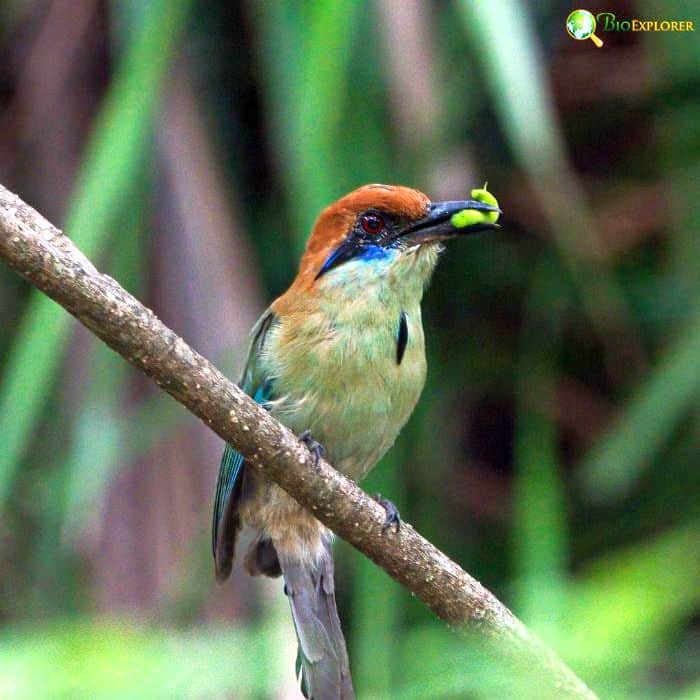
| Animalia | Coraciiformes | Momotidae | Momotus | Momotus mexicanus |
The Russet-crowned Motmot moves like a forest spirit, flashing its earthy green and chestnut colors through Mexico’s dry woodlands. Its most famous feature—a long, pendulum-like tail with bare shafts ending in racket-shaped tips—swings rhythmically with every hop and shift along the branches.
This motmot lives mainly along Mexico’s Pacific slope, from southern Sonora through Sinaloa, Nayarit, Jalisco, Colima, Michoacán, and into northern Guerrero, with an isolated population in central Guatemala. The tropical dry forests near San Blas (Nayarit) and the shaded canyons around Puerto Vallarta (Jalisco) are excellent places to find them. Unlike some of their more tropical cousins, the Russet-crowned Motmot prefers drier forests, scrublands, and brushy ravines, especially close to streams.
Known for their secretive habits, these motmots often perch silently at all levels, twitching their tails as they watch for insects, small reptiles, or berries before making quick, accurate strikes to catch prey.
Interesting Russet-crowned Motmot Facts
- Russet-crowned Motmots dig nesting burrows in earthen banks, creating tunnels that can reach up to six feet deep, ending in a chamber for their eggs.
- Their tail-swinging behavior is thought to signal alertness or communicate with mates, and the tail is fragile and easily broken.
- Both parents share all nesting duties, from digging the tunnel to feeding the young, and are socially monogamous.
- Russet-crowned Motmots’ diet includes large insects, beetles, caterpillars, fruits, and small vertebrates like lizards and frogs, which themselves are often discussed in the context of what do frogs eat, with fruit becoming especially important in the dry season.
- Although still common, Russet-crowned Motmots face threats from habitat loss, climate change, and a shortage of suitable nesting sites, making conserving their forest habitats increasingly important.
15. Violet-crowned Hummingbird
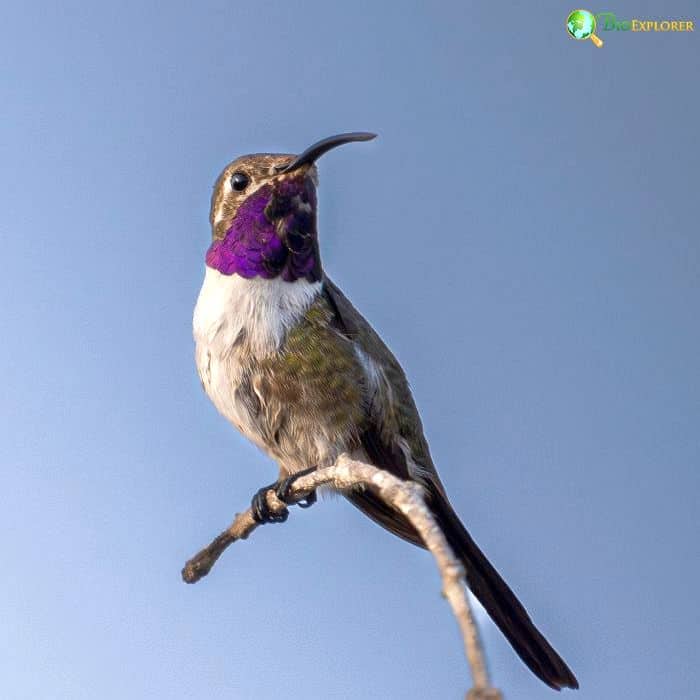
| Animalia | Apodiformes | Trochilidae | Amazilia | Amazilia violiceps |
The Violet-crowned Hummingbird shines with simple but striking beauty. Its bright white underparts contrast with metallic greenish-brown backs and a vivid violet-blue crown that flashes in the sunlight. This bold little hummingbird often dominates feeding areas, chasing away rivals with surprising ferocity despite its small size.
In Mexico, the Violet-crowned Hummingbird ranges from southern Sonora and western Chihuahua south through Durango, Zacatecas, Jalisco, Michoacán, and Guerrero and Oaxaca. Birdwatchers often find them along streams and canyons like the Sierra de Álamos-Río Cuchujaqui Reserve (Sonora) and riparian woodlands near Tala (Jalisco). They favor arid scrublands, open woodlands, and especially riparian corridors with cottonwoods and sycamores, where flowers bloom much of the year.
Violet-crowned Hummingbirds defend their feeding territories fiercely, often perching on exposed twigs to keep watch for intruders. Their brilliant crown is most visible in direct light, giving them a subtle, jewel-like sparkle when seen from the right angle.
Interesting Violet-crowned Hummingbird Facts
- Males perform dramatic aerial displays during courtship, flying in wide arcs and buzzing loudly to impress females.
- Violet-crowned Hummingbirds feed on nectar from various types of flowers, including desert willow and agave, along with small insects and spiders.
- Most populations are year-round residents, but some move locally to follow seasonal blooms or descend to lower elevations in winter.
- Both sexes look nearly identical, a rarity among hummingbirds, with bright white bellies and violet crowns.
- Their heartbeats can reach up to 1,200 beats per minute, powering the rapid wingbeats that let them hover and dart like living jewels.
Wrap-up
Mexico offers some of the most colorful and fascinating birds in the world. Every corner holds rare species and unforgettable sights, from cloud forests to desert canyons. Whether spotting a Resplendent Quetzal in Chiapas or hearing a Blue Mockingbird sing in Jalisco, the magic of Mexico’s birds is never far away. Protecting these habitats ensures that their songs and colors stay part of Mexico’s living beauty.
What’s your favorite Mexican bird from the list? Or did we miss one you love? Let us know — we’d love to hear which feathered beauty caught your eye!



